Purple parrots are a rare and mesmerizing sight, capturing the attention of bird enthusiasts and nature lovers everywhere. Their striking purple plumage and unique behaviors make them one of the most fascinating members of the parrot family. These exotic birds, found in lush tropical regions, are as mysterious as they are beautiful, captivating anyone who sees them. Purple parrots are truly a gem of the avian world, known for their vibrant colors and intriguing habits.
In this blog post, we’ll dive into 10 amazing facts about the purple parrot that will leave you in awe. We’ll explore their vibrant feathers, curious behaviors, and the challenges they face in their natural habitats. This guide will reveal everything you need to know about these extraordinary birds and their unique place in nature. Whether you’re a passionate birdwatcher, an animal lover, or someone fascinated by nature’s wonders, prepare to be amazed. The incredible world of purple parrots offers endless fascination and beauty for anyone who takes the time to learn about them.
What Makes the Purple Parrot So Unique?
Rare Purple Plumage
One of the most remarkable features of the purple parrot is its striking and vibrant plumage. Unlike many other parrots with green, red, or yellow feathers, the purple parrot boasts a unique purple hue. This vibrant color sets it apart in the avian world, making it truly distinctive and beautiful.
The purple plumage is not only visually stunning but also serves practical purposes in their natural habitat. It helps the birds blend into the flowers and fruits, providing camouflage from predators. The pigments responsible for this coloration combine natural melanin with structural feather properties. This combination creates a mesmerizing iridescence that seems to shift shades in the sunlight, adding to their allure.
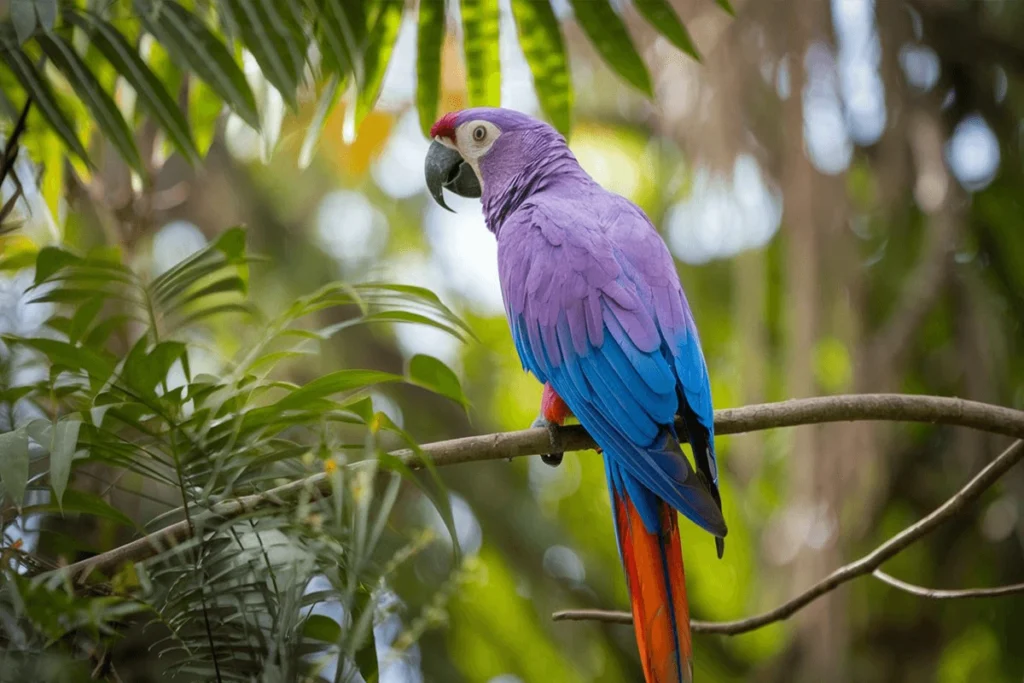
The distinctive coloring of purple parrots also plays a crucial role in attracting mates. During mating season, they use their vibrant feathers to stand out and signal their health and vitality. This display is a clear indicator of their suitability as partners, showcasing nature’s artistry in the animal kingdom.
Exotic Habitat
Purple parrots typically inhabit the lush, tropical regions of the world, where warm climates and abundant food sources allow them to thrive. They live in rainforests, mangroves, and areas near riverbanks, where dense foliage provides protection from predators and ample nesting opportunities.
People often associate these exotic birds with specific regions such as Southeast Asia, parts of South America, and tropical islands. Each habitat offers a unique ecosystem that supports the purple parrot’s diet and social behavior. However, deforestation and urban expansion threaten these birds, forcing them to adapt or migrate to new areas.
Distinctive Behaviors
Purple parrots exhibit a range of distinctive behaviors that make them stand out among other parrot species. Known for their intelligence and playfulness, these birds are highly social and thrive in flocks, where they engage in cooperative activities such as foraging and grooming.
One fascinating behavior is their ability to mimic sounds, including human speech. While not all purple parrots are equally skilled mimics, many have been observed copying the calls of other birds or even imitating environmental sounds like water droplets or wind.
During the mating season, purple parrots perform elaborate courtship rituals, which include dances, vocalizations, and feather displays to attract mates. Their playful nature extends to their interactions with humans when kept as pets, as they form strong bonds with their caregivers and display a knack for problem-solving and learning tricks.
These unique behaviors not only highlight their intelligence but also showcase their adaptability in both the wild and captivity.
Where Does Purple Parrot Lives?
Tropical Regions
Purple parrots are native to tropical regions, where the warm, humid climate provides an ideal environment for their survival. These areas are rich in biodiversity, offering the purple parrot an abundance of food, shelter, and nesting opportunities. The bird’s vibrant plumage is perfectly suited to blend with the colorful flora of tropical rainforests, where shades of purple, red, and green dominate the landscape.
Regions such as Southeast Asia, Central and South America, and specific tropical islands are often associated with purple parrots. In these regions, they inhabit diverse ecosystems ranging from lowland rainforests to mangroves and forest edges near rivers and streams. These areas provide not only sustenance but also a strategic advantage for avoiding predators and maintaining their populations.
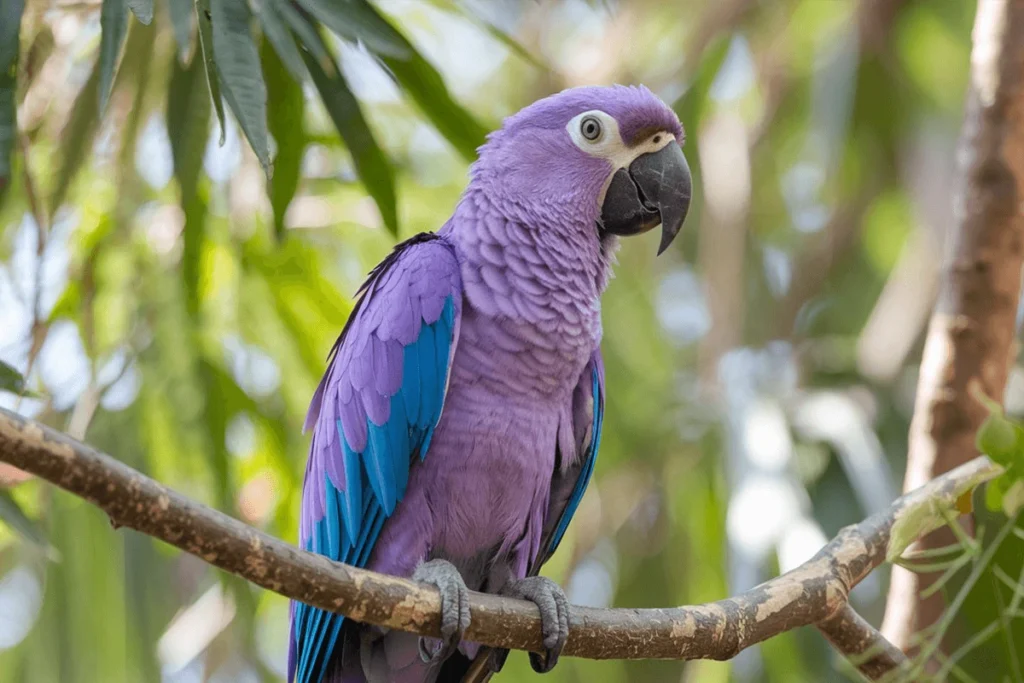
Preferred Habitats
The purple parrot thrives in dense, lush vegetation where they can find plenty of fruits, nuts, and seeds. Rainforests, with their towering trees and thick canopy cover, are a favorite environment, offering both safety and food sources. Within these forests, purple parrots are often seen perching on high branches, which allows them to spot predators while staying close to their food sources.
Mangroves and tropical wetlands are another preferred habitat for purple parrots. These areas provide an abundance of flowering plants and fruiting trees, ensuring a year-round food supply. The dense foliage also offers a safe nesting area where they can lay their eggs and rear their young.
In some cases, purple parrots may also adapt to living near human settlements, particularly in areas where deforestation has limited their natural habitat. Here, they often rely on cultivated crops and garden plants as food sources, showcasing their adaptability in changing environments.
Threats to Habitat
Unfortunately, the tropical habitats that purple parrots call home are increasingly under threat. Deforestation, driven by logging, agriculture, and urban expansion, has led to the destruction of large swathes of rainforest, displacing countless species, including purple parrots. As their habitats shrink, these birds are forced to migrate to less ideal locations, which can impact their survival rates.
Illegal wildlife trade poses another significant threat to purple parrots. Their striking appearance makes them highly sought after as exotic pets, leading to poaching and unsustainable removal from the wild. Habitat loss combined with poaching creates a double burden, putting immense pressure on their populations.
Climate change is also an emerging threat, altering the ecosystems where purple parrots live. Changes in temperature and rainfall patterns can disrupt food availability and nesting cycles, making it harder for these birds to thrive.
Efforts to protect their habitats, such as rainforest conservation programs and stricter regulations on the pet trade, are critical for ensuring the survival of these beautiful birds. By raising awareness and supporting conservation initiatives, we can help preserve the tropical regions that purple parrots call home.
What Do Purple Parrots Eat?
Natural Diet
The natural diet of the purple parrot is as colorful and diverse as the bird itself. These birds are primarily frugivorous, meaning their diet mainly consists of fruits. They favor tropical fruits such as guavas, mangoes, papayas, and figs, which are abundant in their natural rainforest habitats. In addition to fruits, purple parrots consume a variety of seeds, nuts, and berries, providing them with the essential nutrients they need to thrive.
Purple parrots also enjoy nectar and flowers, which supply energy-rich sugars. This feeding habit plays a vital role in their ecosystem as they inadvertently assist in pollination while feeding. Occasionally, they may supplement their diet with insects or small invertebrates, especially during breeding seasons when extra protein is needed.
Feeding Habits
Purple parrots feed opportunistically and eat socially. They often forage in flocks, which helps them locate food sources more efficiently and protect themselves from potential predators. These birds stay most active during the early morning and late afternoon, searching for food in the treetops where fruits and flowers abound.
Their strong, curved beaks crack open nuts and seeds, while their agile tongues extract nectar and manipulate smaller food items. Purple parrots display their dexterity by often using their feet to hold food while eating, highlighting their intelligence and adaptability.
In captivity, caretakers can feed purple parrots a diet that mimics their natural one, including fresh fruits, vegetables, and specially formulated parrot pellets. Providing a varied diet meets their nutritional needs and keeps them mentally stimulated.
Adaptations
The purple parrot has evolved several physical and behavioral adaptations to excel as a forager in its natural habitat.
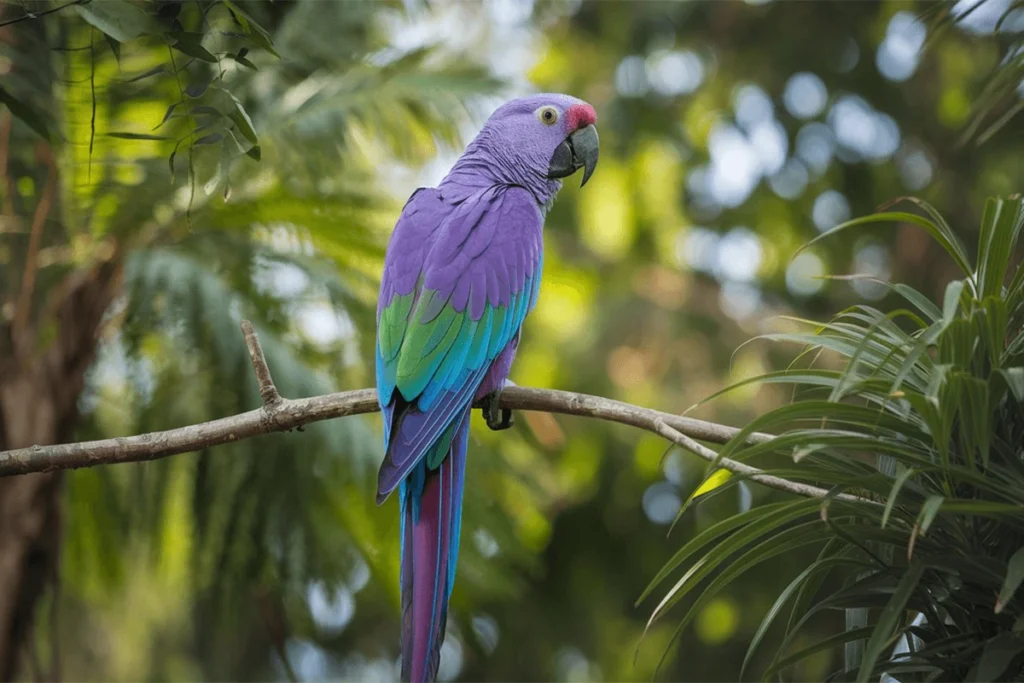
- Beak Design: Their powerful, curved beak is an exceptional tool for breaking hard shells, such as those of nuts and seeds. This adaptation allows them to access food that many other species cannot.
- Agile Feet: Like many parrots, purple parrots have zygodactyl feet, meaning two toes point forward and two point backward. This unique foot structure gives them a firm grip on branches and enables them to hold and manipulate food with precision.
- Color Vision: Their excellent color vision helps them identify ripe fruits and flowers from a distance, making it easier to locate food in dense foliage.
- Social Foraging: By foraging in groups, purple parrots reduce the risk of predation and increase the efficiency of finding food. Their social nature also allows them to learn from one another, especially younger birds observing the feeding habits of experienced adults.
These adaptations not only ensure the purple parrot’s survival in the wild but also underscore its role in maintaining the health and balance of its ecosystem. By spreading seeds and pollinating plants, they contribute to the regeneration of their rainforest homes.
Fun and Lesser-Known Facts About Purple Parrots
Purple Parrot Communication Skills
Purple parrots demonstrate exceptional communication abilities, which play a crucial role in their social interactions and survival. These birds use a diverse repertoire of vocalizations, ranging from melodic calls to squawks, to convey various messages. Whether warning their flock about a nearby predator, signaling the discovery of food, or engaging in mating calls, their vocal skills are integral to their daily lives.
One of the most fascinating aspects of purple parrots is their ability to mimic sounds, including human speech. While not all individuals exhibit this skill, many parrots in captivity replicate words and phrases they frequently hear. This mimicry extends beyond speech to include environmental sounds like doorbells, alarms, or other bird calls. This ability is linked to their intelligence and complex brain structure, particularly the region responsible for vocal learning.
In the wild, their communication skills help maintain flock cohesion. They rely on a mix of vocal and non-vocal signals, such as body language and feather displays, to express emotions like aggression, affection, or curiosity.
Purple Parrot Social Behavior
Purple parrots are highly social birds, thriving in the company of their flock. They live in groups ranging from small family units to large flocks of up to 50 individuals, depending on the species and habitat. This social structure offers numerous benefits, including protection from predators, easier foraging, and opportunities for learning.
Their social interactions are characterized by playful behavior, such as chasing, preening, and engaging in mock fights. These activities not only strengthen bonds within the flock but also provide mental stimulation and exercise. Young parrots, in particular, learn important survival skills by observing and imitating older flock members.
During the breeding season, their social behaviors become even more fascinating. Male purple parrots engage in elaborate courtship rituals to attract mates, which may include vocal performances, wing flapping, and presenting food to the female. Once paired, they form strong monogamous bonds and often share responsibilities like nest building and chick rearing.
In captivity, their social nature makes them highly interactive with their human caregivers. They often form strong attachments to their owners and can become emotionally distressed if left alone for extended periods.
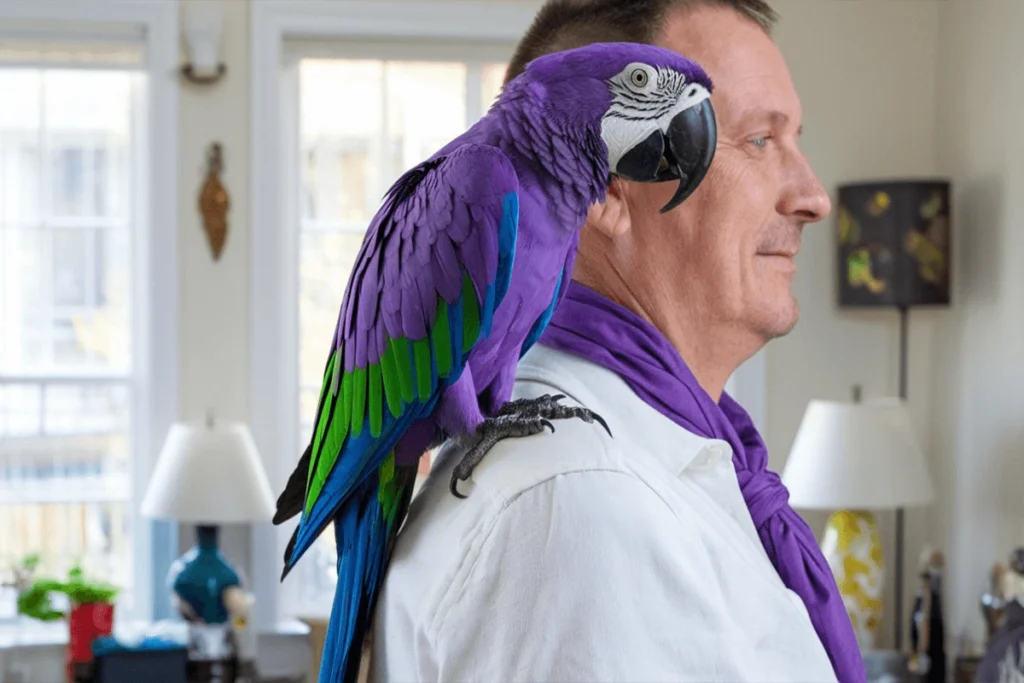
Purple Parrot Lifespan
The lifespan of a purple parrot varies depending on factors such as species, environment, and diet. In the wild, these birds typically live between 20 to 30 years, though some species have been known to reach up to 40 years in ideal conditions. Factors like predation, habitat destruction, and food scarcity can influence their lifespan in the wild.
In captivity, where they are protected from predators and provided with consistent care, purple parrots often live longer. With proper diet, mental stimulation, and a healthy environment, they can reach ages of 40 to 50 years, and in some cases, even longer. This longevity makes them a lifelong commitment for pet owners.
To ensure a long and healthy life, purple parrots require a balanced diet, regular veterinary care, and ample opportunities for mental and physical enrichment. Their long lifespan is a testament to their resilience and adaptability, but it also underscores the importance of creating stable and supportive conditions for these remarkable birds, whether in the wild or in captivity.
Conservation Status and How to Protect The Purple Parrot Birds
Endangered or Not?
The conservation status of purple parrots depends on the specific species in question. While some species of parrots with vibrant purple plumage are not currently classified as endangered, others face significant threats that could impact their populations. Factors such as habitat destruction, illegal poaching, and climate change contribute to the vulnerability of these birds.
For instance, purple parrots that inhabit regions undergoing rapid deforestation may be classified as “vulnerable” or “near threatened” by organizations like the International Union for Conservation of Nature (IUCN). In contrast, those in more protected environments may maintain stable populations. Regular monitoring of these species is crucial to assess their status and implement necessary protective measures.
Threats Purple Parrot Faces
Purple parrots face a range of threats that jeopardize their survival in the wild:
- Habitat Loss: The primary threat to purple parrots is deforestation, driven by logging, agriculture, and urbanization. As rainforests are cleared, these birds lose their nesting sites and food sources, forcing them to migrate to less ideal environments.
- Illegal Wildlife Trade: Their striking appearance makes purple parrots highly sought after in the exotic pet trade. Poaching not only removes them from their natural habitats but also disrupts their breeding cycles, further endangering wild populations.
- Climate Change: Rising temperatures and shifting weather patterns impact the ecosystems purple parrots rely on. Changes in rainfall can affect the availability of fruits and flowers, making it harder for these birds to find food and breed successfully.
- Predation: In the wild, purple parrots are vulnerable to predators such as snakes, birds of prey, and mammals, especially when nesting. Habitat destruction exacerbates this risk by reducing their ability to hide or escape.
How You Can Help
Supporting the conservation of purple parrots involves a combination of individual actions and broader advocacy efforts:
- Support Conservation Organizations: Donate to or volunteer with organizations that work to protect tropical rainforests and endangered species. Groups like the World Wildlife Fund (WWF) and BirdLife International focus on habitat preservation and combating illegal wildlife trade.
- Promote Sustainable Practices: Reduce your ecological footprint by choosing products that are sustainably sourced. Look for certifications like FSC (Forest Stewardship Council) when buying wood or paper products to ensure they come from responsibly managed forests.
- Raise Awareness: Share information about the plight of purple parrots and the importance of biodiversity. Social media, blogs, and community events are powerful platforms for educating others and inspiring action.
- Avoid Exotic Pets: Resist the temptation to buy exotic birds, as this demand fuels illegal poaching and trafficking. Instead, support sanctuaries and adoption programs that provide homes for rescued animals.
- Advocate for Policy Change: Support legislation aimed at protecting wildlife and their habitats. Contact policymakers and encourage stronger enforcement of laws against deforestation and wildlife trafficking.
By taking these steps, individuals can contribute to the preservation of purple parrots and the vibrant ecosystems they inhabit, ensuring future generations can marvel at these extraordinary birds.
Conclusion
The purple parrot is truly a marvel of nature, with its vibrant plumage, fascinating behaviors, and vital role in tropical ecosystems. From their unique adaptations and communication skills to the challenges they face in the wild, these extraordinary birds captivate and inspire anyone fortunate enough to encounter them.
As we’ve explored in this post, purple parrots are not only beautiful but also a reminder of the delicate balance of our planet’s biodiversity. Whether they’re helping to pollinate plants, dispersing seeds, or enchanting us with their mimicry, these birds are essential contributors to their ecosystems. However, the threats they face, including habitat loss and illegal poaching, highlight the urgent need for conservation efforts.
By supporting initiatives that protect their habitats, advocating for sustainable practices, and spreading awareness, we can all play a part in ensuring that purple parrots continue to thrive for generations to come. Let’s celebrate the beauty and wonder of these remarkable birds and take steps to preserve their place in the wild.
If you enjoyed learning about the purple parrot, don’t forget to share this post and explore more about the incredible world of exotic birds. Together, we can make a difference!
Find Some Useful Stuff For you Pet On PetMD Official
Get Helpful Tips for your pet Here
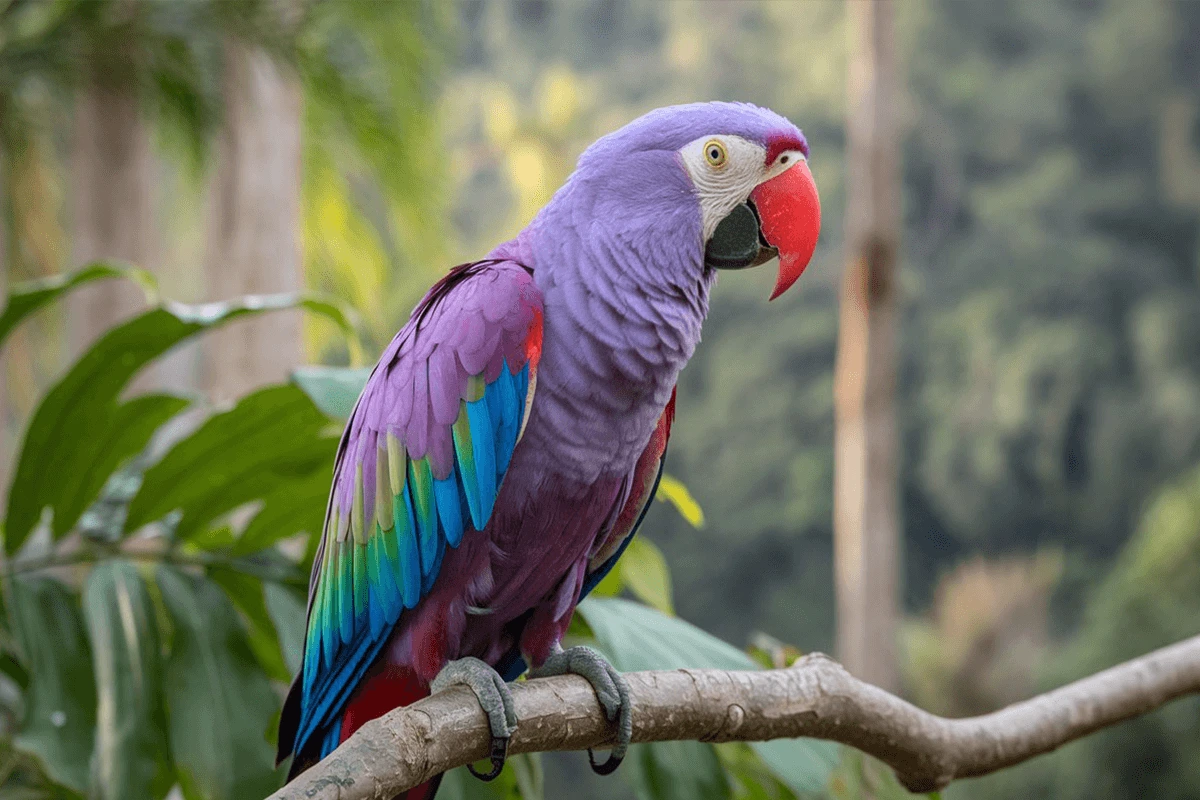
3 thoughts on “10 Amazing Facts About the Purple Parrot You’ll Love”
Comments are closed.